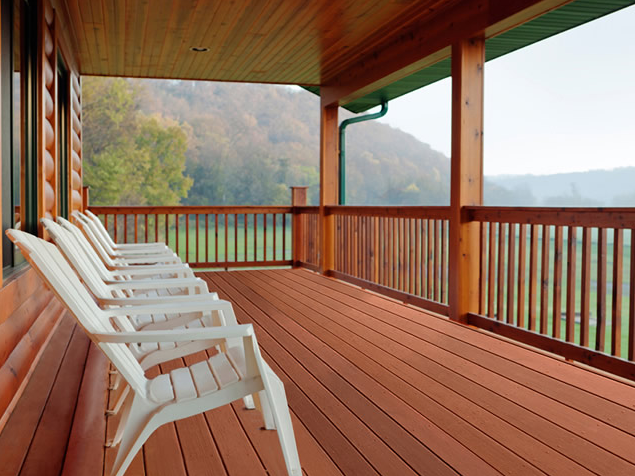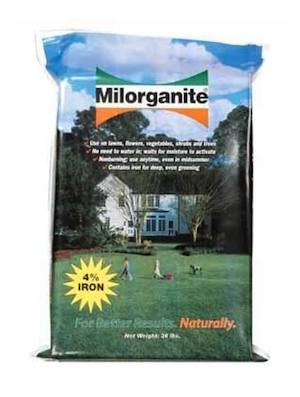Milorganite Lawn Fertilizer
A conventional grass lawn can have a large environmental footprint, from the large amount of water needed to keep it green, to the fossil fuel usage and air pollution associated with mowing it. As we have mentioned in earlier articles, planting 'no mow' and drought-resistant grass can greatly reduce these environmental inputs.
But any kind of lawn or grass is going to benefit from regular feedings of fertilizer to keep the grass strong and healthy. And that's another environmental impact that needs to be considered if you want your grass lawn to be as 'green' as possible.
The Dark Side of Conventional Synthetic Fertilizers
Most commercially available lawn fertilizers on the market today are synthetic (also called 'chemical' or 'inorganic').
Synthetic fertilizers typically contain blends of nitrogen, salts, minerals, and other chemicals designed for lawns.
While a healthy lawn requires many of these, synthetic fertilizers have a number of environmental drawbacks.
- Runoff from chemical fertilizers can enter waterways, contributing to pollution and oxygen depletion in streams and rivers. Synthetic fertilizer ingredients leach from the soil easily and wash away without breaking down.
- Synthetic fertilizer will decrease a soil's fertility over time, making it harder for grass to thrive. Beneficial microbes in the soil can be killed by synthetic fertilizer, which can contribute to increased lawn disease and fungus (which require even more chemicals to treat!)
- The use of synthetic fertilizer (and associated pesticides) can harm beneficial earthworms. Worms help aerate the soil, benefiting the root system of grasses.
- Most synthetic fertilizers are made from fossil fuels and other nonrenewable resources, which many people are concerned about. Sources of nitrogen (ammonium sulfate, urea, ammonia) are byproducts of the gas and oil industries, and the production and use of synthetic fertilizers can contribute to increased buildup of greenhouse gases.
- Synthetic fertilizers may seem to be cheaper and faster acting, but over time their disadvantages will start to build up, ultimately harming your lawn's ecosystem.
Back to Nature with Milorganite Lawn Fertilizer
There are plenty of all-natural fertilizers on the market today that can alleviate all of the drawbacks of synthetic fertilizers while still keeping your lawn green and healthy. Most natural fertilizers are made from animal manures or other by-products of the agricultural industry.
One of the best-selling, most widely available all-natural fertilizers is Milorganite Lawn Fertilizer. And you might not believe where it comes from.
The Milorganite Lawn Fertilizer Story
In 1919, the city of Milwaukee, Wisconsin adopted a new process for dealing with its wastewater. Air is allowed to bubble through wastewater for a set period of time. After the air is turned off and the waste mixture settles, the water was purified. This process was called the activated sludge process.
One drawback of this new process was the large amount of leftover solids, the microbes left behind by the treatment process. At the time, the city of Milwaukee was creating 70,000 tons of dried microbe waste a year, too much to simply send to a landfill.
Early on, a professor at the University of Wisconsin College of Agriculture studied this solid waste, determining that it was 6.2 percent nitrogen, 2.65 percent phosphate and 0.4 percent soluble potash, all comparable to commercial fertilizers of the day. Experiments with vegetables and field crops, then on the fairways at Maple Bluff Country Club in Madison found this solid waste to be superior to other fertilizers at one third the cost. It also did not burn the plants with over-application, and it produced a dark, thick green turf of grass. And Milorganite was born!
MIL-waukee-ORGAnic-NITrogEN
Milorganite gained its commercial name from a contest in 1925, and the Milwaukee Sewage Commission started selling Milorganite in late 1925.
The Advantages of Milorganite for a Really 'Green' Lawn
Today, Milorganite is widely available nationwide at many lawn and garden centers, or online HERE. In addition to being a completely natural, renewable fertilizer, Milorganite has many other advantages:
- It can be spread with any brand of fertilizer spreader. Simply follow the settings listed on the Milorganite bag.
- Milorganite is 100% safe for children and pets. Milorganite meets even the most stringent health, safety, and environmental criteria. It is non-toxic if eaten in small amounts (though this is obviously not recommended!)
- Milorganite does not need to be watered in. The organic nutrients in Milorganite are 'stored' in complex organic molecules until soil microbes break down and release them. Synthetic fertilizers need to be watered in to begin working.
- Milorganite can be applied at any time of the summer, even during droughts. Milorganite contains no salts which can burn grasses during hot, dry periods.
- Milorganite fertilizer does not contain any pesticides or weed killers, but will help create a thick turf which will choke out weeds over time. Milorganite can be used in conjunction with other lawn care products such as weed or pest killers as part of a complete lawn maintenance program.
- Milorganite can be used on any plant that grows outdoors, including vegetable gardens, edible crops, or landscape plants.
- Milorganite is foolproof to apply. Over-application won't cause any harm to grasses or other plants.
- Phosphorous in synthetic chemical fertilizers is a concern since the phosphates can run off and contribute to water pollution in streams and rivers. Milorganite does contain a small amount of phosphorous, which is beneficial to grass. The phosphorous in Milorganite, however, is slow moving and will stay in the soil. Soil tests in Florida conclude that Milorganite phosphorous stays in the soil where applied and does not contribute to phosphate runoff.
Go Green With Milorganite Lawn Fertilizer
Yes, it is true. Milorganite is made from the processed bio-solids leftover from human wastewater treatment. This may seem creepy to some at first, but when you consider the environmental benefits of using it, and see the results it brings, you will be a believer. We at Green Home Source have used Milorganite on our own lawn for years, and it does work, and at a fair price too. Milorganite is 100% safe, and it is treated in a way that it doesn't harbor any type of disease. It has no offensive odors (in fact it has a pleasing, 'organic' smell to it). It's easy to apply. We think you'll be more than happy treating your grass lawn (or gardens) with 100% natural Milorganite.
Click HERE to visit the official Milorganite website.
comments powered by Disqus







































































































































